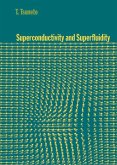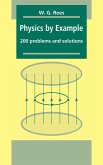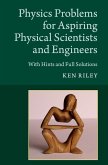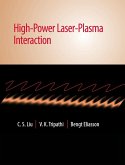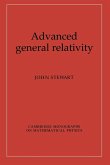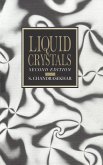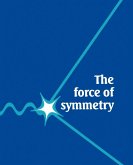- Broschiertes Buch
- Merkliste
- Auf die Merkliste
- Bewerten Bewerten
- Teilen
- Produkt teilen
- Produkterinnerung
- Produkterinnerung
Graduate text on superconductivity, an area of intense research activity worldwide.
Andere Kunden interessierten sich auch für
![Superconductivity and Superfluidity Superconductivity and Superfluidity]() T. TsunetoSuperconductivity and Superfluidity144,99 €
T. TsunetoSuperconductivity and Superfluidity144,99 €![Physics by Example Physics by Example]() Gareth ReesPhysics by Example113,99 €
Gareth ReesPhysics by Example113,99 €![Physics Problems for Aspiring Physical Scientists and Engineers Physics Problems for Aspiring Physical Scientists and Engineers]() Ken RileyPhysics Problems for Aspiring Physical Scientists and Engineers80,99 €
Ken RileyPhysics Problems for Aspiring Physical Scientists and Engineers80,99 €![High-Power Laser-Plasma Interaction High-Power Laser-Plasma Interaction]() C. S. LiuHigh-Power Laser-Plasma Interaction85,99 €
C. S. LiuHigh-Power Laser-Plasma Interaction85,99 €![Advanced General Relativity Advanced General Relativity]() John StewartAdvanced General Relativity77,99 €
John StewartAdvanced General Relativity77,99 €![Liquid Crystals Liquid Crystals]() S. ChandrasekharLiquid Crystals200,99 €
S. ChandrasekharLiquid Crystals200,99 €![The Force of Symmetry The Force of Symmetry]() Vincent IckeThe Force of Symmetry77,99 €
Vincent IckeThe Force of Symmetry77,99 €-
-
-
Graduate text on superconductivity, an area of intense research activity worldwide.
Hinweis: Dieser Artikel kann nur an eine deutsche Lieferadresse ausgeliefert werden.
Hinweis: Dieser Artikel kann nur an eine deutsche Lieferadresse ausgeliefert werden.
Produktdetails
- Produktdetails
- Verlag: Cambridge University Press
- Seitenzahl: 512
- Erscheinungstermin: 9. August 2003
- Englisch
- Abmessung: 246mm x 189mm x 27mm
- Gewicht: 980g
- ISBN-13: 9780521565622
- ISBN-10: 0521565626
- Artikelnr.: 21034126
- Herstellerkennzeichnung
- Libri GmbH
- Europaallee 1
- 36244 Bad Hersfeld
- gpsr@libri.de
- Verlag: Cambridge University Press
- Seitenzahl: 512
- Erscheinungstermin: 9. August 2003
- Englisch
- Abmessung: 246mm x 189mm x 27mm
- Gewicht: 980g
- ISBN-13: 9780521565622
- ISBN-10: 0521565626
- Artikelnr.: 21034126
- Herstellerkennzeichnung
- Libri GmbH
- Europaallee 1
- 36244 Bad Hersfeld
- gpsr@libri.de
Part I. Phenomenological Theories of Suoerconductivity: 1. Introduction
2. The London-London equation
3. Pippard's equation
4. Thermodynamics of type I superconductor
5. The intermediate state
6. Surface energy between a normal and a superconducting metal
7. Quantized vorticity
8. Type II superconductivity
9. The Ginzburg-Landau theory
10. The upper critical field of a type II superconductor
11. The anisotropic superconductor
12. Superconductivity in thin slabs
13. Surface superconductivity
14. The type II superconductor for H just below Hc2
15. The Josephson effect
16. The Josephson lattice in 1D
17. Vortex structures in layered superconductors
18. Granular superconductors
the Josephson lattice in 2D and 3D
19. Wave propagation in Josephson junctions, superlattices and arrays
20. Flux pinning and flux motion
21. Time dependent Ginzburg-Landau theory
22. Fluctuation effects
23. Ginzburg-Landau theory of an unconventional superfluid
24. Landau Fermi liquid theory
Part II. The Microscopic Theory of a Uniform Superconductor: 25. The Cooper problem: pairing of two electrons above a filled Fermi sea
26. The Bardeen-Cooper-Schrieffer theory of the superconducting ground state
27. Elementary excitations
the Bogoliubov-Valatin transformation
28. Calculation of the thermodynamic properties using the Bogoliubov-Valatin method
29. Quasiparticle tunneling
30. Pair tunneling: the microscopic theory of the Josephson effects
31. Simplified discussion of pairing mechanisms
32. The effect of Coulomb repulsion on Tc
33. The two band superconductor
34. Time dependent perturbations
35. Non equilibrium superconductivity
Part III. Non Uniform Superconductors: 36. Bogoliubov's self-consistent potential equations
37. Self consistency conditions and the free energy
38. Linearized self consistency and the correlation function
39. Behaviour of the correlation function in the clean and dirty limits
40. Self consistency condition
41. Effects involving electron spin
42. Boundary conditions
43. The proximity effect at zero field
44. Proximity effect in a magnetic field
45. Derivation of the Ginzburg-Landau theory
46. Gauge invariance
Diamagnetism in the low field limit
47. The quasi-classical case
48. The isolated vortex line
49. Time dependent Bogoliubov equations
50. The response of a superconductor to an electromagnetic field
51. The Bogoliubov equations for an unconventional superfluid
53. Superfluid 3He
54. Collective modes in normal and superfluid Fermi systems
55. Green's functions
Appendix A. The occupation number representation
Appendix B. Some calculations involving the BCS wavefunction
Appendix C. The gap as a perturbation through third order
References
Additional reading
List of mathematical and physical symbols
Index.
2. The London-London equation
3. Pippard's equation
4. Thermodynamics of type I superconductor
5. The intermediate state
6. Surface energy between a normal and a superconducting metal
7. Quantized vorticity
8. Type II superconductivity
9. The Ginzburg-Landau theory
10. The upper critical field of a type II superconductor
11. The anisotropic superconductor
12. Superconductivity in thin slabs
13. Surface superconductivity
14. The type II superconductor for H just below Hc2
15. The Josephson effect
16. The Josephson lattice in 1D
17. Vortex structures in layered superconductors
18. Granular superconductors
the Josephson lattice in 2D and 3D
19. Wave propagation in Josephson junctions, superlattices and arrays
20. Flux pinning and flux motion
21. Time dependent Ginzburg-Landau theory
22. Fluctuation effects
23. Ginzburg-Landau theory of an unconventional superfluid
24. Landau Fermi liquid theory
Part II. The Microscopic Theory of a Uniform Superconductor: 25. The Cooper problem: pairing of two electrons above a filled Fermi sea
26. The Bardeen-Cooper-Schrieffer theory of the superconducting ground state
27. Elementary excitations
the Bogoliubov-Valatin transformation
28. Calculation of the thermodynamic properties using the Bogoliubov-Valatin method
29. Quasiparticle tunneling
30. Pair tunneling: the microscopic theory of the Josephson effects
31. Simplified discussion of pairing mechanisms
32. The effect of Coulomb repulsion on Tc
33. The two band superconductor
34. Time dependent perturbations
35. Non equilibrium superconductivity
Part III. Non Uniform Superconductors: 36. Bogoliubov's self-consistent potential equations
37. Self consistency conditions and the free energy
38. Linearized self consistency and the correlation function
39. Behaviour of the correlation function in the clean and dirty limits
40. Self consistency condition
41. Effects involving electron spin
42. Boundary conditions
43. The proximity effect at zero field
44. Proximity effect in a magnetic field
45. Derivation of the Ginzburg-Landau theory
46. Gauge invariance
Diamagnetism in the low field limit
47. The quasi-classical case
48. The isolated vortex line
49. Time dependent Bogoliubov equations
50. The response of a superconductor to an electromagnetic field
51. The Bogoliubov equations for an unconventional superfluid
53. Superfluid 3He
54. Collective modes in normal and superfluid Fermi systems
55. Green's functions
Appendix A. The occupation number representation
Appendix B. Some calculations involving the BCS wavefunction
Appendix C. The gap as a perturbation through third order
References
Additional reading
List of mathematical and physical symbols
Index.
Part I. Phenomenological Theories of Suoerconductivity: 1. Introduction
2. The London-London equation
3. Pippard's equation
4. Thermodynamics of type I superconductor
5. The intermediate state
6. Surface energy between a normal and a superconducting metal
7. Quantized vorticity
8. Type II superconductivity
9. The Ginzburg-Landau theory
10. The upper critical field of a type II superconductor
11. The anisotropic superconductor
12. Superconductivity in thin slabs
13. Surface superconductivity
14. The type II superconductor for H just below Hc2
15. The Josephson effect
16. The Josephson lattice in 1D
17. Vortex structures in layered superconductors
18. Granular superconductors
the Josephson lattice in 2D and 3D
19. Wave propagation in Josephson junctions, superlattices and arrays
20. Flux pinning and flux motion
21. Time dependent Ginzburg-Landau theory
22. Fluctuation effects
23. Ginzburg-Landau theory of an unconventional superfluid
24. Landau Fermi liquid theory
Part II. The Microscopic Theory of a Uniform Superconductor: 25. The Cooper problem: pairing of two electrons above a filled Fermi sea
26. The Bardeen-Cooper-Schrieffer theory of the superconducting ground state
27. Elementary excitations
the Bogoliubov-Valatin transformation
28. Calculation of the thermodynamic properties using the Bogoliubov-Valatin method
29. Quasiparticle tunneling
30. Pair tunneling: the microscopic theory of the Josephson effects
31. Simplified discussion of pairing mechanisms
32. The effect of Coulomb repulsion on Tc
33. The two band superconductor
34. Time dependent perturbations
35. Non equilibrium superconductivity
Part III. Non Uniform Superconductors: 36. Bogoliubov's self-consistent potential equations
37. Self consistency conditions and the free energy
38. Linearized self consistency and the correlation function
39. Behaviour of the correlation function in the clean and dirty limits
40. Self consistency condition
41. Effects involving electron spin
42. Boundary conditions
43. The proximity effect at zero field
44. Proximity effect in a magnetic field
45. Derivation of the Ginzburg-Landau theory
46. Gauge invariance
Diamagnetism in the low field limit
47. The quasi-classical case
48. The isolated vortex line
49. Time dependent Bogoliubov equations
50. The response of a superconductor to an electromagnetic field
51. The Bogoliubov equations for an unconventional superfluid
53. Superfluid 3He
54. Collective modes in normal and superfluid Fermi systems
55. Green's functions
Appendix A. The occupation number representation
Appendix B. Some calculations involving the BCS wavefunction
Appendix C. The gap as a perturbation through third order
References
Additional reading
List of mathematical and physical symbols
Index.
2. The London-London equation
3. Pippard's equation
4. Thermodynamics of type I superconductor
5. The intermediate state
6. Surface energy between a normal and a superconducting metal
7. Quantized vorticity
8. Type II superconductivity
9. The Ginzburg-Landau theory
10. The upper critical field of a type II superconductor
11. The anisotropic superconductor
12. Superconductivity in thin slabs
13. Surface superconductivity
14. The type II superconductor for H just below Hc2
15. The Josephson effect
16. The Josephson lattice in 1D
17. Vortex structures in layered superconductors
18. Granular superconductors
the Josephson lattice in 2D and 3D
19. Wave propagation in Josephson junctions, superlattices and arrays
20. Flux pinning and flux motion
21. Time dependent Ginzburg-Landau theory
22. Fluctuation effects
23. Ginzburg-Landau theory of an unconventional superfluid
24. Landau Fermi liquid theory
Part II. The Microscopic Theory of a Uniform Superconductor: 25. The Cooper problem: pairing of two electrons above a filled Fermi sea
26. The Bardeen-Cooper-Schrieffer theory of the superconducting ground state
27. Elementary excitations
the Bogoliubov-Valatin transformation
28. Calculation of the thermodynamic properties using the Bogoliubov-Valatin method
29. Quasiparticle tunneling
30. Pair tunneling: the microscopic theory of the Josephson effects
31. Simplified discussion of pairing mechanisms
32. The effect of Coulomb repulsion on Tc
33. The two band superconductor
34. Time dependent perturbations
35. Non equilibrium superconductivity
Part III. Non Uniform Superconductors: 36. Bogoliubov's self-consistent potential equations
37. Self consistency conditions and the free energy
38. Linearized self consistency and the correlation function
39. Behaviour of the correlation function in the clean and dirty limits
40. Self consistency condition
41. Effects involving electron spin
42. Boundary conditions
43. The proximity effect at zero field
44. Proximity effect in a magnetic field
45. Derivation of the Ginzburg-Landau theory
46. Gauge invariance
Diamagnetism in the low field limit
47. The quasi-classical case
48. The isolated vortex line
49. Time dependent Bogoliubov equations
50. The response of a superconductor to an electromagnetic field
51. The Bogoliubov equations for an unconventional superfluid
53. Superfluid 3He
54. Collective modes in normal and superfluid Fermi systems
55. Green's functions
Appendix A. The occupation number representation
Appendix B. Some calculations involving the BCS wavefunction
Appendix C. The gap as a perturbation through third order
References
Additional reading
List of mathematical and physical symbols
Index.


